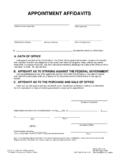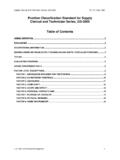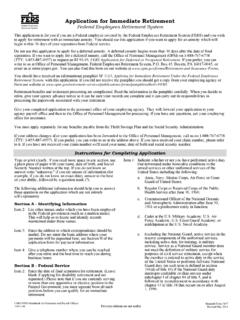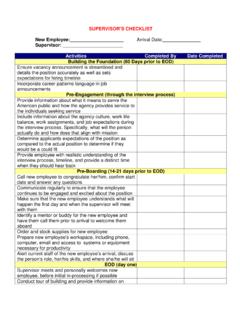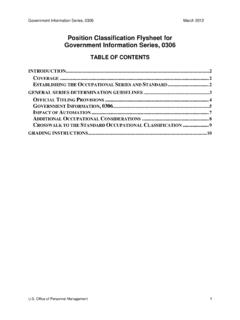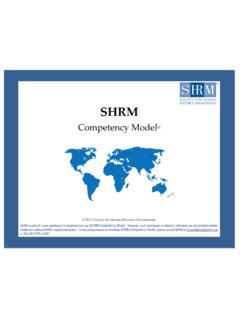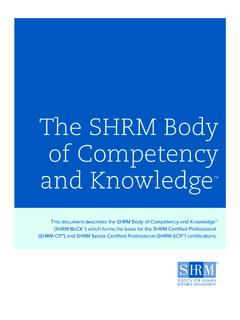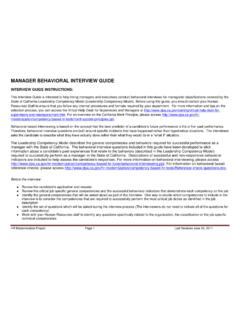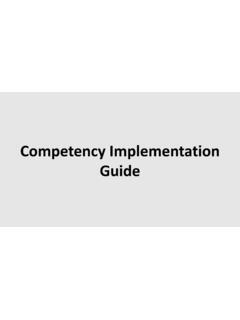Transcription of Human Resources Specialist (Performance Management ...
1 1 Human Resources Specialist (Performance Management / Employee Relations / Labor Relations) Career Path Guide Office of the CHCO Council Office of Personnel Management , Suite 5H27 1900 E Street, NW, Washington, DC 20415 2 Table of Contents Introduction .. 3 Understanding the Career Path Diagrams .. 3 Understanding Success Factors .. 3 Understanding the competency Information .. 4 Understanding the Training Areas .. 5 Understanding the Critical Developmental Activities .. 5 Qualifications 5 Human Resources Specialist (Performance Management /Employee Relations/ Labor Relations) Career Path Success Factors .. 7 Entry-Level Career Stage .. 9 Entry-Level, GS- 5/7/9 .. 10 Full Performance Career Stage .. 15 Full Performance, GS-11/12 .. 16 Expert/Managerial Career Stage .. 22 Expert, GS-13/14/15 .. 23 3 Introduction This guide contains a detailed career path for an individual working in the Performance Management /Employee Relations / Labor Relations specialty area.
2 Career paths, and the information associated with them, are extremely useful in planning a career. In essence, they represent a road map that shows: (1) how people advance through a career, (2) qualifications and competencies required at each career stage, and (3) suggested activities, such as developmental activities and formal training, that strengthen competencies. This career path was developed by subject matter experts working in the Human Resources Management (HRM) Series (GS-0201) at agencies across the Federal Government. As such, the information contained in this career path reflects expert recommendations regarding the developmental experiences that prepare individuals at each career stage for the next level. While the grade at which individuals enter the HR occupation and the full performance level of each position varies greatly across the Federal Government, for purposes of this guide, we have defined Entry- Level as GS-5/7/9, Full Performance as GS-11/12, Expert as GS-13/14/15, and Managerial as GS-15/SES.
3 There are several important points that you should keep in mind as you review this guide. While the career paths described are recommended by experts, these are not the only ways to succeed. There are many avenues to success as a Human Resources Specialist . Regardless of the specific path that your career follows, you should constantly strive to strengthen the competencies that are relevant to your career goals. The developmental experiences described are not the only ones that contribute to career success. While these experiences were specifically identified by job experts as being important, there are many other experiences that will also help you to gain the competencies needed to be successful. Understanding the Career Path Diagrams The career paths outline typical avenues for moving among and across jobs in ways that facilitate growth and career advancement. Within this guide, there are two types of career path diagrams.
4 The first diagram, shown after this section, is a general overview of your specialty area and describes the career as a whole. Arrows represent movement between career stages or specialty areas. An additional set of detailed diagrams shows movement that occurs within each career stage ( , Entry-Level, Full Performance, and Expert/Team Leader/Supervisor/Managerial). For both diagrams, solid arrows depict the most common career moves, while dotted arrows show less common, yet equally feasible career moves. Understanding Success Factors Success factors are typically broad in scope and can be viewed as pieces of advice from senior members who have reflected on their experience in the HR field and provided statements on how to maximize performance and career advancement. You will notice that many of the success factors are not tied to any particular specialty area or career stage. After reading through the success factors, you should seek clarification from your supervisor on how best to implement some of the suggestions.
5 4 Understanding the competency Information For each of the points along the career path ( , Entry Level), the guide identifies both general and technical competencies. A competency is the combination of knowledge, skill, and/or ability one needs to successfully perform a job function. General competencies cut across occupations, while technical competencies are specific to an occupation and/or specialty area. This guide provides definitions of the technical competencies along with illustrative work behaviors. Mastering the activities listed under each of the technical competency sections may increase your likelihood of success, within both your current and future positions. For both general and technical competencies, a desired proficiency level is listed for each competency . The numeric proficiency scale used for the competencies in this guide is shown below: Proficiency Level General Competencies Technical Competencies 5 = Expert Applies the competency in exceptionally difficult situations.
6 Serves as a key resource and advises others. Applies the competency in exceptionally difficult situations. Serves as a key resource and advises others. Demonstrates comprehensive, expert understanding of concepts and processes. 4 = Advanced Applies the competency in considerably difficult situations. Generally requires little or no guidance. Applies the competency in considerably difficult situations. Generally requires little or no guidance. Demonstrates broad understanding of concepts and processes. 3 = Intermediate Applies the competency in difficult situations. Requires occasional guidance. Applies the competency in difficult situations. Requires occasional guidance. Demonstrates understanding of concepts and processes. 2 = Basic Applies the competency in somewhat difficult situations. Requires frequent guidance. Applies the competency in somewhat difficult situations.
7 Requires frequent guidance. Demonstrates familiarity with concepts and processes. 5 1 = Awareness Applies the competency in the simplest situations. Requires close and extensive guidance. Applies the competency in the simplest situations. Requires close and extensive guidance. Demonstrates awareness of concepts and processes. Understanding the Training Areas Training areas are subjects for study that strengthen either general or technical competencies. By seeking training in these subject areas, you can maximize success within the current role and prepare for advancement to the next. Some of these training areas will be linked to internal training courses offered by your agency, while others may be linked to external training provided by Government or non-Governmental sources. You should discuss these training areas and/or courses with your manager to determine your options for completing formal coursework in your field.
8 Keep in mind, however, that much of your training may occur through on-the-job experiences like those listed under Critical Developmental Activities. Understanding the Critical Developmental Activities Critical developmental activities are experiences employees can seek as they move through the career paths. Each of these experiences is associated with a specific career stage and provides the opportunity to strengthen both general and technical competencies. Within each career stage, the developmental activity may be the same but will vary in complexity depending on the grade level. The experiences listed in this document are recommended, but not required. Before you engage in a particular developmental experience, you should discuss the experience with your manager. Remember that workload considerations may affect the ability of your supervisor to provide you with some of the developmental assignments suggested in this document.
9 For this reason it is a good idea to seek out opportunities for learning that may not involve formal assignments. When you and your supervisor have agreed on a developmental experience, discuss what you should gain from the experience. Qualifications Requirements Please note that this guide is for development purposes only and does not address position requirements or your eligibility for a particular job. For information about Governmentwide qualifications requirements, please refer to Additionally, there may be position-specific requirements, including specialized experience. Your supervisor can provide more information on these additional requirements. Human Resources Specialist (Performance Management / Employee Relations / Labor Relations) Career Path Overview 6 Entry-Level (GS-5/7/9) Full Performance (GS-11/12) Expert (GS-13/14/15) Hired from outside the Federal Government Other specialties within Performance Management /Employee Relations/Labor Relations: Classification Compensation Employee Benefits Information Systems Recruitment and Placement Human resource Development Managerial (GS-15/SES) Executive Services Policy Transfer from another job series This graphic shows a bird s eye view of how individuals progress through career stages in the Human resource Management Series, 0201.
10 Solid arrows represent the most common careeradvancement; dotted arrows represent equally viable, but less common advancement. As this diagram shows, it is fairly common for individuals to transfer into or out of a specialized Performance Management /Employee Relations/Labor Relations position at the Entry-Level stage and into one of the specialty areas listed in the top box. This becomes less common at the Full Performance and Expert stages. At the Full Performance and Expert stages, it is more common for individuals to transfer into the specialty areas listed in the box directly underneath these stages ( , Executive Services or Policy). 7 Success Factors Success factors provide general advice and guidance regarding your Human Resources Management career. These statements are not tied to any specific position, grade, qualification requirement, or developmental experience. Career Movement Obtain expertise in staffing and classification as this knowledge is foundational; it is also important for success at higher levels of HR.

